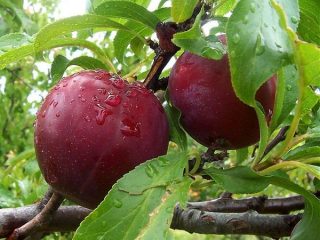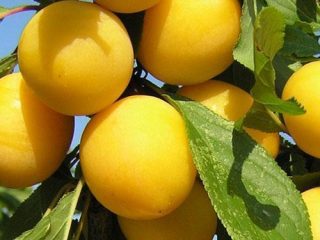Content
The description of the cherry plum variety July Rose allows you to form a general idea of the culture, which is very popular among gardeners in Russia. The brainchild of Kuban breeders opens the fruit and berry season and is distinguished by its excellent taste characteristics and ease of care.

Cherry plum July Rose - a bright leader from the line of early varieties
History of selection
The hybrid cherry plum July Rose has several names: “June Rose”, “Cherry plum Comet Early”. The variety was bred at the experimental breeding station of the city of Krymsk (Krasnodar Territory) by G.V. Eremin and S.N. Zabrodina. Crimean branch of the All-Russian Research Institute of Plant Growing named after. N.I.Vavilova in the Krasnodar Territory is the originator of the early hybrid species of cherry plum July Rose. During breeding work, the parent variety “Kuban Comet” was used. A garden crop called July Rose was included in the State Register of Breeding Achievements of the Russian Federation in 1999.
The originator declares the following main characteristics of the July Rose:
- the variety is self-sterile;
- high precocity from 3 years of age;
- annual high fruiting from 8 years of age to 10 kg of berries;
- high winter hardiness;
- average drought resistance;
- high degree of adaptation to various living conditions;
- stable immunity to pathogens and pests.

Early cherry plum July Rose is recommended for cultivation in the North Caucasus region, the territory of the Stavropol and Krasnodar Territories, the republics of Dagestan, Ingushetia, Adygea, Crimea, North Ossetia-Alania, Chechnya, Kabardino-Balkaria
Description of the variety
The early cherry plum hybrid July Rose is characterized by the following varietal characteristics:
- medium-sized tree, up to 3 m high;
- the trunk is gray, smooth, with an average number of small lentils;
- the crown is flattened-rounded, medium thick;
- shoots are arched, weakly branched, horizontal;
- shoot diameter up to 2.5-3.5 cm;
- the bark of the shoots is brown-red, with a green tip;
- bouquet branches are short, short-lived (2-3 years), with a large number of inflorescences;
- generative buds are small, round, pressed against the shoot;
- leaf blades are slightly pubescent on the underside, oval with a pointed apex, slightly wavy, large, with glands on an arched base;
- leaf color is green, shiny;
- leaf size 6.5 cm x 4.5 cm;
- flowering - early April;
- inflorescence 2-flowered;
- flower size up to 2 cm in diameter;
- the corolla is weakly closed, with small, round, slightly corrugated white petals measuring 7 mm x 7.5 mm, with slightly curved stamens (up to 30 pcs.) and yellow anthers;
- ovary bare;
- berry ripening - end of June;
- Asymmetrical drupes: height - 4.1 cm, thickness - 3.7 cm, width - 3.7 cm;
- fruit weight up to 32 g;
- the skin of the fruit is elastic, with a weakly defined abdominal seam, with a slight waxy coating, and is difficult to separate from the pulp;
- skin color: main - yellow, outer skin - solid red with a pink tint;
- the pulp is low-juicy, medium-dense, thin, fibrous-granular, with an average number of subcutaneous yellow dots;
- The color of the pulp is yellow; when cut, it darkens slowly in air;
- the aroma of the pulp is faintly plum-like;
- the taste of the pulp is sweet and sour;
- the stone is oval with a wide ventral suture, weighing 0.7 g, not completely separated from the pulp.
In the photo is the July Rose cherry plum, which is characterized by its high yield. The average life cycle of a plant with proper agricultural technology is up to 15 years.
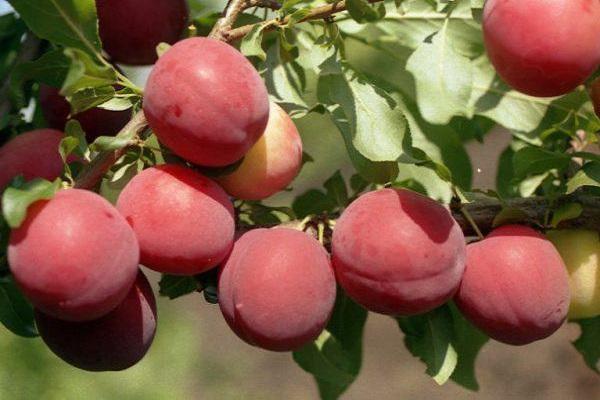
The July Rose cherry plum is characterized by an excellent taste; the official tasting assessment of fresh fruit is 4.4 points
Characteristics
Cherry plum of the early hybrid variety July Rose easily takes root and is characterized by unpretentious care. The main characteristics of the July Rose cherry plum allow one to determine the subtleties of agricultural technology.
Drought resistance, winter hardiness
The cherry plum variety July Rose is characterized by a high degree of frost resistance (up to - 36 ⁰C) and winter hardiness in the official tolerance region, according to the recommendations of the originator.
Drought resistance is average; the crop requires additional watering during dry summers.If over-irrigated, the July Rose may be susceptible to aphid attacks.
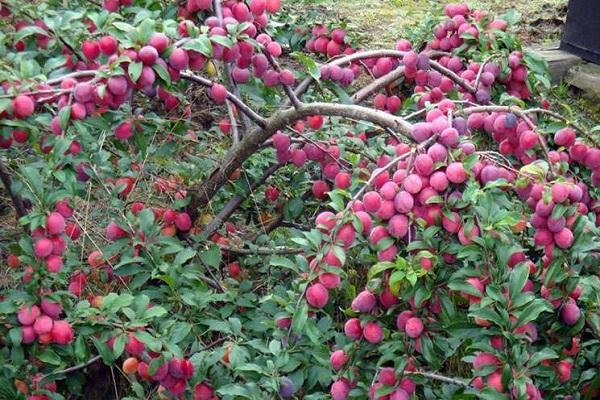
In general, the July Rose variety easily adapts and adapts to various unfavorable living conditions, withstands snow, rain, and strong winds
Pollinators of cherry plum July Rose
In the State Register of Breeding Achievements, the cherry plum variety July Rose is positioned as a self-sterile crop.
The originator of the variety, in turn, pays attention to partial self-fertility and, in order to improve the taste quality of the fruit and increase yield, recommends placing the crop next to pollinating varieties that are characterized by the same flowering period (“Found”, “Traveler”, “ Pramen").
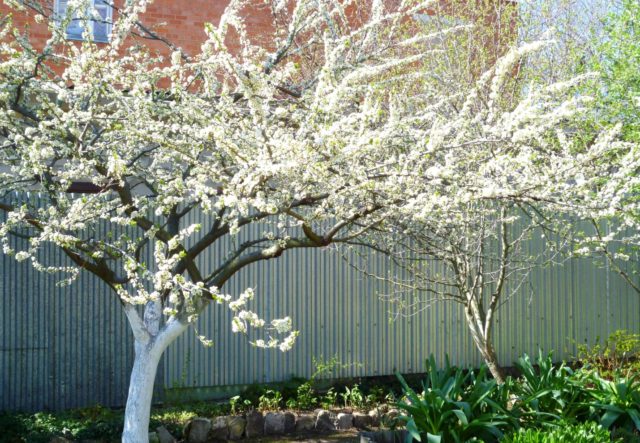
By placing Comet Early next to pollinating cherry plum varieties, it is possible to increase the level of crop productivity
Flowering period and ripening period
The flowering period of the July Rose occurs in the first days of April. Cherry plum inflorescences are expressed by two flowers, as well as a large number of flowers on one shoot. The calyx is bell-shaped with sepals pressed to the petals.
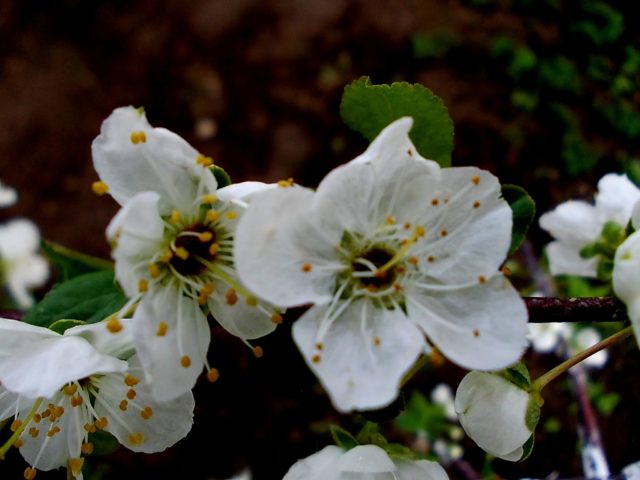
The snow-white inflorescences of early June cherry plum Comet Early envelop the garden in a veil of heady spring aroma
Productivity and fruiting
The cherry plum variety July Rose enters the active fruiting phase at 3-4 years of age. By the age of 8, the tree produces record yields (up to 10 kg in one season).
Fruiting of the July Rose begins in June and lasts several weeks. Fruit ripening is uneven, but the yield is regular and stable. Since the fruits are unstable on the stalks, the harvest should be done immediately, as the cherry plum ripens. Ripe fruits become red-burgundy, sweet, juicy.

Over the entire life cycle of the July Rose variety, there are no pronounced declines in productivity indicators
Area of application of fruits
According to experts, the taste characteristics of cherry plum variety July Rose are rated at 4.4 points. Ripe fruits have an optimal sugar-acid index - 3.0, they contain the maximum amount of natural components:
- up to 7.8% sugar;
- up to 2.3% acids;
- up to 10.9% dry matter;
- up to 6.67% vitamin C.
Cherry plum of this variety is a universal product that is used fresh, for processing and preservation with great success.
Transportability and keeping quality of the fruit are average. Transportation of cherry plum is possible subject to proper storage. For the first 7-10 days, fruits removed from the tree are stored open, in a wooden box. They can last up to 1 month in a dark, cool room.
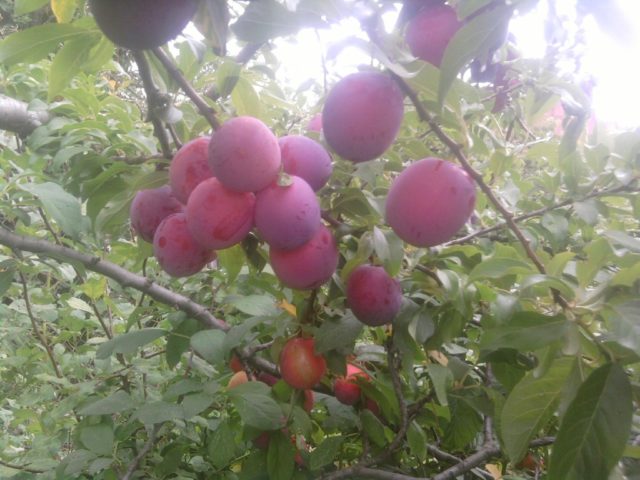
High-quality cherry plum products July Rose were given a high degree of evaluation by experts: compote - 4.4 points, juice with pulp - 4.0 points, jam - 4.5 points
Resistance to diseases and pests
The culture has stable immunity to the main pathogens. The early hybrid cherry plum variety Comet Early is practically not affected by pests.
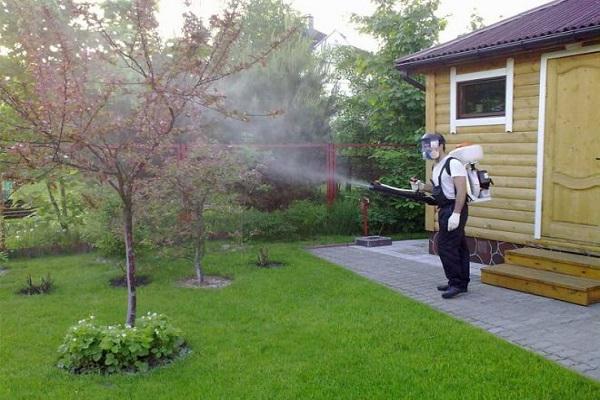
When the first signs of diseases and pests appear, trees should be promptly treated with modern fungicides and insecticides
Advantages and disadvantages
The early ripening cherry plum hybrid July Rose compares favorably with other fruit trees in terms of fruit ripening. The vitamin composition of the pulp has undoubted benefits for the human body.
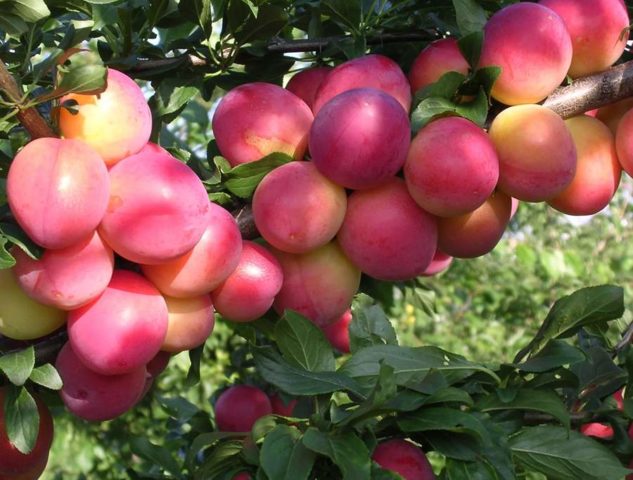
The moderately juicy pulp of the July Rose has delicious taste characteristics
Pros:
- early ripeness;
- high productivity;
- original plum flavor;
- large fruit size;
- stable immunity to diseases and pests;
- endurance in various climatic conditions.
Minuses:
- partial self-fertility;
- uneven ripening;
- average level of drought resistance.
Landing Features
Experienced gardeners place emphasis on autumn planting of cherry plum seedlings in open ground in the regions of admission. Since the culture is unpretentious and undemanding, there are no special difficulties or requirements for agricultural technology.
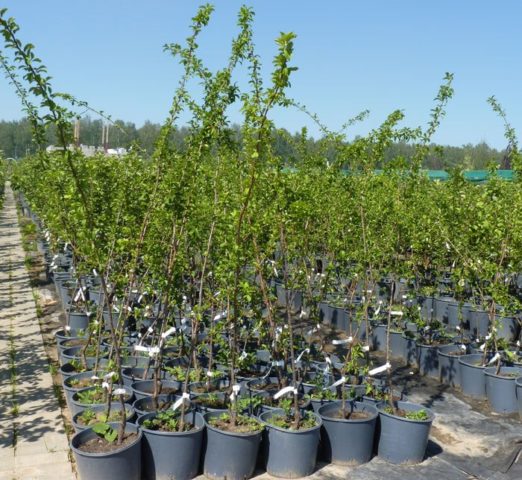
July Rose - a magnificent early cherry plum variety for a small garden
Recommended timing
Cherry plum seedlings July Rose can be moved into open ground in spring or autumn (from April to October).
In spring, trees are replanted before the period of active sap flow begins, provided they are at rest. When purchasing seedlings with a closed root system, they can be moved to open ground at any time from April to October.
Saplings with an open root system can most often be purchased at specialized nurseries in the fall. Autumn planting is most preferable for plants.
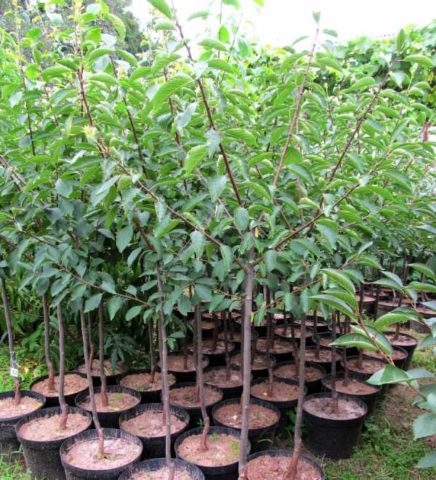
When planting cherry plum in the fall, during hibernation, the plants are easier to adapt to a new place
Choosing a suitable location
The most favorable place for placing cherry plum trees is the southwestern or southern slopes. The ideal option would be a protective barrier from wind and bad weather made of trees or buildings on the north or northeast side. In addition, the following factors are important for the plant:
- no shading;
- the presence of loose, well-drained, neutral soil;
- lack of swampiness and contact with groundwater.
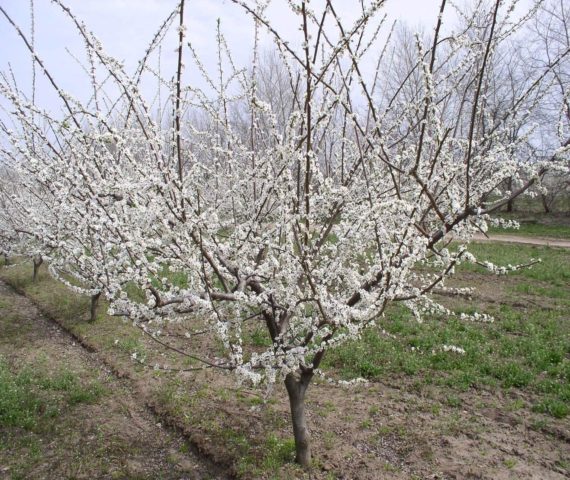
In favorable conditions, cherry plum will develop faster and produce high-quality and abundant harvests.
What crops can and cannot be planted next to cherry plum
Cherry plum is compatible with such crops as apple, gooseberry, raspberry, black currant, maple, and elderberry. Maple stimulates the fruiting of cherry plums, and elderberry blocks aphid attacks.
The cherry plum tree is uncomfortable with birch and various fruit trees, except apple trees.
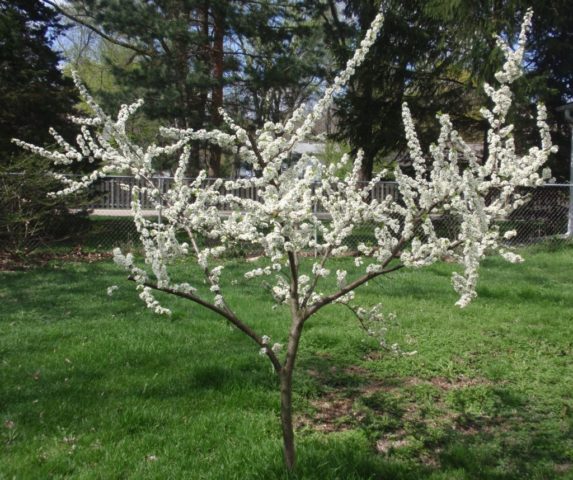
Experienced flower growers recommend planting decorative bushes and grass under the tree so that falling fruits do not become deformed when falling
Selection and preparation of planting material
The July Rose cherry plum seedling should have a healthy appearance:
- well developed fibrous roots;
- absence of cones, growths, dry and rotten branches on the roots;
- healthy, smooth bark without cracks or damage on the trunk and branches.
You should purchase 2-year-old seedlings, since older crops are more difficult to adapt, take root more difficult, and are characterized by later fruiting.
Before planting in open ground, the root system should be placed in water for several hours. To stimulate growth, growth stimulants are added to the water: Epin, Heteroauxin, Kornevin.
Landing algorithm
The planting hole is formed in such a way that the root system can be placed. The optimal hole size for a 2-year-old cherry plum seedling is 40 cm x 100 cm. Drainage made of expanded clay, crushed stone or broken brick, up to 15 cm thick, is placed at the bottom of the planting hole. The nutrient mixture for filling the planting hole should consist of equal parts:
- black soil;
- sand;
- bottom peat;
- humus;
- 400-500 g of superphosphate;
- 3 liters of wood ash.
The planting hole with a nutrient soil mixture must be prepared in advance and covered with roofing material or slate to prevent the leaching of useful substances during the rainy season. When favorable conditions occur, the seedlings are transferred to open ground. Part of the soil is removed from the planting hole and the algorithm is followed:
- a mound is formed in the center of the hole;
- at a small distance from the center (at a distance of 10-15 cm), a peg up to 1.2 m high is driven in;
- the seedling is placed on a mound in such a way that the roots are freely distributed along the slopes of the mound, and the neck of the root system is located at the top of the mound;
- the seedling is sprinkled with earth, thoroughly compacted, and tied to a wooden peg;
- a trunk circle is formed around the tree;
- The young tree is watered (10 liters of water per seedling).
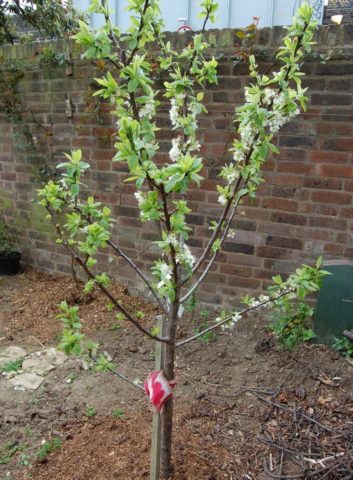
2-3 hours after planting, the tree trunk circle can be mulched with sawdust, peat, hay or compost
Subsequent care of the crop
Regular care of the hybrid cherry plum July Rose consists of the following steps:
- watering once every 3 weeks with deep moistening of the soil 25 cm deep at the rate of 3-4 buckets of water per adult tree;
- removal and weeding of weeds for aeration;
- loosening to ventilate the root system;
- caring for the tree trunk circle (mulching during the first 2-3 years of life with a 10-centimeter layer of humus or peat with periodic changes 3-4 times per season);
- sanitary pruning of the branches of the July Rose, forming the crown 2 times during the growing season (in the spring, mainly in March before buds open, removing lateral branches by 20 cm, rejuvenating pruning in the 8th year of life);
- fertilizing with nitrogen-containing mineral fertilizers in the spring for the 3-4th year of life;
- inspection for signs of diseases and pests;
- timely harvesting;
- preparation for winter - whitewashing the trunks to prevent the appearance of burns in the spring, covering the tree trunk with a casing made of sheet iron with burlap wrapping (relevant for the regions of the Middle Zone and Trans-Urals).

After pruning old branches of the July Rose, the cut sites should be treated with garden varnish to prevent the entry of pathogenic flora
Diseases and pests, methods of control and prevention
The hybrid cherry plum variety Comet Early is resistant to pathogens and insect attacks. In some cases, the July Rose cherry plum can become infected with the following ailments:
- Trees become infected with coccomycosis from mid-July; brown or red spots appear on the foliage.
To prevent coccomycosis, you can apply a lime solution to the trunks of the July Rose cherry plum and treat the crown with Topsin-M and Horus preparations.
- Marsupial disease provokes a decrease in yields by more than 2 times. The fungus affects fruits that are characterized by an elongated shape, green color with a white coating.
The fruits of the July Rose cherry plum affected by marsupial disease cannot be eaten, they are destroyed, and in the spring the trees are treated with Bordeaux mixture or the Horus preparation.
- Fungal moniliosis is a monilial burn or fruit rot. In spring, burn ulcers form on foliage and flowers. Fruit rot affects ripe fruits, which become dry. Subsequently, the fungus can spread to the trunk.
To treat moniliosis on the July Rose, use a solution of mustard powder (80 g of dry mustard per 10 liters of water) or the drug “Fitolavin”, which is used to treat cherry plum trees of the July Rose variety in the spring during flowering
The main “enemies” of culture are:
- Caterpillars of the subcortical leaf roller. They make holes in the bark and wood, as a result the tree slows down its growth, the side branches dry out, and the yield decreases.
Subcortical leaf roller butterflies can be caught using pheromone traps; insecticide treatment is required to inactivate the larvae
- Plum aphid. It settles on the July Rose in huge colonies, sucks juices from plants, causes a decrease in yield, and sometimes the death of fruit trees.
To get rid of plum aphids on July Rose cherry plum trees, you can plant aromatic herbs nearby: coriander, mint, parsley, dill; carry out treatment with the preparations “Confidor”, “Fufanon”, “Aktara”
- Wrinkled sapwood. A small beetle that “with appetite” absorbs all parts of the July Rose tree.
If larvae or adult beetles are detected, damaged branches of the July Rose cherry plum should be promptly removed
Timely prevention helps prevent the manifestation of diseases:
- crown thinning;
- removing remnants of vegetation under trees before winter;
- treating trees with 1% Bordeaux mixture (Hom mixture) before flowering and 2 weeks after flowering;
- treatment of trees with a 3% solution of copper sulfate in early spring before the start of sap flow.

Slimy sawfly larvae eat leaves; to get rid of pests, you can spray cherry plum trees July Rose with infusion of wormwood, chamomile, or use biological agents “Fitoverm”, “Lepidotsid”
Conclusion
The description of the cherry plum variety July Rose gives a general idea of the main characteristics of the plant. The fruit tree is characterized by early ripening, high winter hardiness, average drought resistance, high yield and active fruiting. With proper care, ripe fruits are large in size and have excellent taste.
Reviews of cherry plum July Rose











